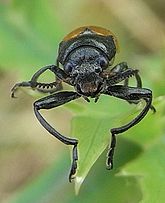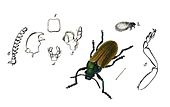Labidostomis tridentata
| Labidostomis tridentata | ||||||||||||
|---|---|---|---|---|---|---|---|---|---|---|---|---|

Labidostomis tridentata |
||||||||||||
| Systematics | ||||||||||||
|
||||||||||||
| Scientific name | ||||||||||||
| Labidostomis tridentata | ||||||||||||
| ( Linnaeus , 1758) |
Labidostomis tridentata , sometimes also called the birch-neck long-legged leaf beetle , is a beetle fromthe leaf beetle family and the subfamily Cryptocephalinae . The beetle, which is rare in Central Europe, shows a clear sexual dimorphism (Fig. 1 and 2). It is similar to the common ant bag beetle .
The species is listed in the Red List of Endangered Species in Germany and Schleswig-Holstein under category 3 (endangered). In North Rhine-Westphalia it is considered to be "highly endangered".
Comments on the name and the system
The species was first described by Linnaeus in 1758 under the name Chrysomela tridentata as the 49th species of the 176th genus. The description consists of six words: Chrysomela cylindrica, thorace caerulea, elytris testaceis ( lat. A cylindrical chrysomela , body blue, wing covers brick-colored). So Linnaeus gives no indication of why he calls the species "tridentata" (Latin: three teeth). Fabricius lists the species as Cryprocephalus tridentatus , Olivier as Clytra tridentata . Today the species is assigned to the genus Labidostomis . The generic name is from Altgr. λαβής labís, labídos, forceps and στόμα stóma, mouth derived. Reitter mentions the previous division of the genera according to the shape of the front edge of the head shield . In labidostomis , the side corners of the head shield protrude angularly. This probably explains the generic name. In Labidostomis tridentata there is still a tooth between the two side corners of the head shield. This possibly explains the species name tridentata .
In Europe the genus Labidostomis is represented with three subgenera and 32 species. Around forty species are distinguished worldwide.
Characteristics of the beetle
The body is cylindrical and trimmed in front and behind. It reaches a length of 6.5 to 8.5 millimeters. The gender dimorphism is very pronounced. The head and pronotum are metallic green or blue, the wing covers yellow-brown.
The head points downwards perpendicular to the body axis. The front corners of the head shield are tooth-like, especially in the male. The upper lip is rectangular (Fig. 4, No. 1) and brown-black, only the front edge is reddish. The mandibles end in two teeth (Fig. 4, No. 2). The eleven-part antennae (Fig. 4, No. 6) are short and relatively thin. The fourth link is wider, but only slightly longer than the third. The antennae are only sawn from the fifth link. The first antennae are yellow, the sawn part of the antennae is blue.
The pronotum is almost twice as wide as it is long. The posterior corners of the pronotum are raised and lie above the level of the elytra (Fig. 1). The puncture of the pronotum is clear, but unevenly dense.
The elytra are monochrome yellow-brown and have no shoulder patch. Together they are only a little wider than the pronotum.
The front hips are close together. In the male, the front hips and the other parts of the front legs are greatly elongated and the front rails are strongly bent up (Fig. 2). The legs (Fig. 4, No. 5) end in tarsi , which apparently consist of four limbs, since the very small fourth tarsal limb is hidden at the base of the third tarsal limb.
 Fig. 1: Front view of the female Fig. 2: Front view of the male  |
 Fig. 3: Top view Fig. 4: Derivative of plate 582 by John Curtis : British Entomology, 1: upper lip, 2: upper jaw, 3: lower jaw with jaw feeler, 4: lower lip with lip feeler, 5: foreleg, 6: feeler, L: larva  |
biology
The adults are found from May to August in warm and dry locations, for example on the edges of forests and on bushes, on dry floodplains and brooks or in sand pits. Hazel , birch and willow species as well as spar shrubs are specified as feeding plants .
The female lays bundles of five to twenty-five white eggs on birch leaves. Each egg is surrounded by a sheath of excrement, which the female spreads around the egg with her hind tarsi. The eggs in a bundle are connected to one another by thin threads of excrement.
The larvae (Fig. 4, L) live in a pear-shaped, hairy sack that is open on the narrow side. The legs are well developed.
distribution
The species is common in almost all of Europe and beyond. In the south there are reports from all Mediterranean countries with the exception of Greece , to the north the distribution area in Scandinavia reaches the Arctic Circle . In the west, data are only missing from Portugal and Ireland , in the east the distribution area extends over Siberia to Mongolia and northern China . In Central Europe, however, the species is rare, in many places the last reports were years ago.
literature
- Heinz joy, Karl Wilhelm Harde, Gustav Adolf Lohse (ed.): The beetles of Central Europe . tape 9 . Cerambycidae Chrysomelidae . Spektrum Akademischer Verlag, Munich 1999, ISBN 3-8274-0683-8 (first edition: Goecke & Evers, Krefeld 1966).
- Klaus Koch : The Beetles of Central Europe . Ed .: Heinz Freude . tape 3 : ecology . Goecke & Evers, Krefeld 1992, ISBN 3-87263-042-3 . P.58
Individual evidence
- ↑ a b Red Lists at BioNetworkX
- ↑ a b Labidostomis tridentata in Fauna Europaea. Retrieved January 12, 2011
- ↑ C.Linnaeus: Systema Naturae per Regna tria naturae, secundum classes, ordines, genera, species, cum characteribus, differentiis, synonymis, locis. Tomus I. Editio decima, reformata Stockholm 1758 first description page 395
- ↑ Sigmund Schenkling: Explanation of the scientific beetle names (species)
- ↑ GAOlivier : Encyclopaedia methodique: histoire naturelle: insects p.31 . IV band KGLutz 'Verlag, Stuttgart 1912, page 83.
- ↑ Sigmund Schenkling: Explanation of the scientific beetle names (genus)
- ↑ Edmund Reitter : Fauna Germanica, the beetles of the German Empire, Volume IV, KGLutz 'Verlag, Stuttgart 1912, p. 83.
- ↑ Labidostomis in Fauna Europaea. Retrieved March 3, 2013
- ↑ Labidostomis Chlorostola (subgenus) in Fauna Europaea. Retrieved March 3, 2013
- ↑ Labidostomis Labidostomis (subgenus) in Fauna Europaea. Retrieved March 3, 2013
- ↑ Labidostomis Wellschmiedia (subgenus) in Fauna Europaea. Retrieved March 3, 2013
- ↑ Species of the genus Labidostomis at BioLib
- ↑ WWFowler, H. St.J Donisthorpe The Coleoptera of the British Islands Vol VI (Supplement) London 1913 Description of egg laying p. 162
- ↑ John Curtis : British Entomology Vol.13
- ^ Re-discovery in Lower Saxony
Web links
Web links
- C.Fuss: Contributions to the Käferfaune Transylvania negotiations and communications of the Transylvanian Society for Natural Sciences in Sibiu, Vol. VII No. 1 1854–57 Description of the doll, p.37